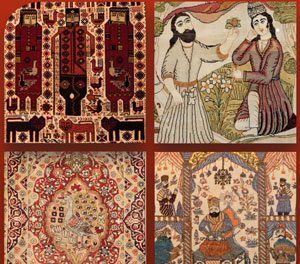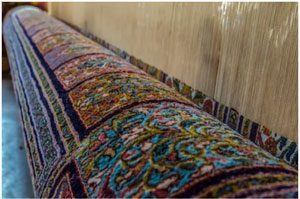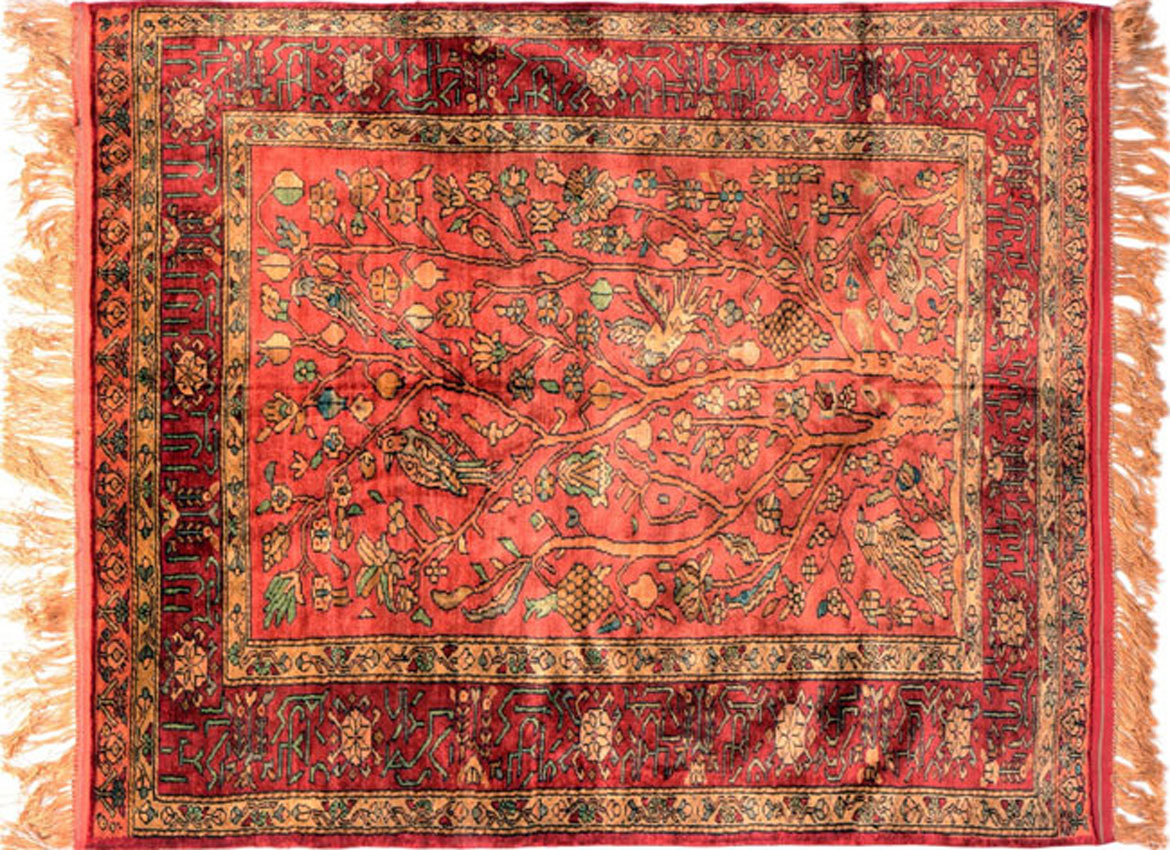[vc_row][vc_column][vc_custom_heading text=”The art of carpet weaving in Iran originated more than 2,500 years ago. Persian carpets and rugs were initially woven as articles of necessity to cover the floors of nomadic tribesmen, giving them protection from the cold and damp.” font_container=”tag:h2|font_size:24|text_align:left” use_theme_fonts=”yes” el_class=”semibold” css=”.vc_custom_1541180033090{margin-top: 0px !important;margin-bottom: 0px !important;}”][martfury_empty_space height=”50″][vc_column_text]
 The natural evolution of the skills and craft required in creating these works of art has been passed down from generation to generation over the centuries in times of peace, invasion, and war. With the development of international trade, the variety of patterns and designs grew.
The natural evolution of the skills and craft required in creating these works of art has been passed down from generation to generation over the centuries in times of peace, invasion, and war. With the development of international trade, the variety of patterns and designs grew.
Much of the development of the Persian carpet is related to the country’s various rulers over time. When Cyrus the Great was Babylon in 539 BC. It is said that the tomb of Cyrus, who was buried in Pasargadae near Persepolis, was covered with precious carpets. Even before his time, it is very likely that Persian nomads created at least very simple designs for their own homes. They provided their flocks of sheep and goats with high-quality, long-lasting wool.
In 1949 Russian archaeologists discovered the oldest known knotted carpet in the Pazyryk Valley, in the Altai Mountains in Siberia. The Pazyryk carpet dates from the 5th century BC. And is a fine example of the craftsmanship that has been developed and refined over the centuries. The carpet survived for two millennia in the frozen graves of the Scythian nobles and is today the showpiece of the Hermitage in Leningrad (St. Petersburg). The complexity of this rug suggests that by this early stage the art of rug weaving had gone well beyond simple rugs for practical purposes.
The first documented evidence of the existence of carpets comes from Chinese texts from the Sassanid dynasty (AD 224-641). In AD 628, Emperor Heraclius brought back a variety of carpets from the conquest of Ctesiphon, the Sassanid capital. The Arabs also conquered Ctesiphon in AD 637, and among the booty they brought with them were said to have included many carpets, including the famous garden carpet, the “Spring of Khosro”. This carpet went down in history as the most precious of all time. The carpet, made during the reign of Khosro I (531-579 AD), was huge, measuring 400 x 100 and weighing several tons. Historians describe the silk-based carpet as follows: “The border was a magnificent flowerbed of blue, red, white, yellow, and green stones; in the background the color of the earth was imitated with gold; clear stones like crystals gave the illusion of water; the plants were made of silk and the fruits were formed from colored stones. “The king is said to have strolled across the carpet in winter to remind him of the beauty of spring. However, when the Arabs invaded, they cut the splendid carpet into many pieces and sold each piece individually.
[/vc_column_text][martfury_empty_space height=”50”][vc_column_text]
Today, carpet weaving is by far the most widespread handicraft in Iran.
[/vc_column_text][martfury_empty_space height=”50″][vc_column_text]After the rule of the Arab caliphates, a Turkish tribe named after their founder conquered Persia. Their reign (1038-1194 AD) was of great importance in the history of the Persian carpets. The Seljuk women were skilled carpet weavers with Turkish knots. In the provinces of Azerbaijan and Hamadan, where the Seljuk influence was strongest and longest, the Turkish knot is still used today.[/vc_column_text][/vc_column][/vc_row][vc_row][vc_column][martfury_empty_space height=”50″][vc_custom_heading text=”Persian carpet is amongst the most treasured of possessions.” font_container=”tag:h2|font_size:20|text_align:center” use_theme_fonts=”yes” el_class=”semibold” css=”.vc_custom_1541180883891{margin-top: 0px !important;margin-bottom: 0px !important;}”][martfury_empty_space height=”30″][vc_column_text]
 The Mongol conquest and control of Persia (1220-1449) was initially brutal. However, they soon came under the influence of the Persians. The palace of Tabriz, which belonged to the Ilkhan leader Ghazan Khan (1295-1304), had paved floors covered with precious carpets. The Mongol ruler Shah Rokh (1409 – 1446) contributed to the rebuilding of much that was destroyed by the Mongols and promoted all artistic activities in the region. However, during this period the carpets were decorated with simple motifs, which were mainly of a geometric style.
The Mongol conquest and control of Persia (1220-1449) was initially brutal. However, they soon came under the influence of the Persians. The palace of Tabriz, which belonged to the Ilkhan leader Ghazan Khan (1295-1304), had paved floors covered with precious carpets. The Mongol ruler Shah Rokh (1409 – 1446) contributed to the rebuilding of much that was destroyed by the Mongols and promoted all artistic activities in the region. However, during this period the carpets were decorated with simple motifs, which were mainly of a geometric style.
The Persian carpet reached its peak during the rule of the Safavid dynasty in the 16th century AD. Around 1500 copies are kept in various museums and private collections around the world. During the reign of Shah Abbas (1587-1629), trade and handicrafts flourished in Persia. Shah Abbas promoted contacts and trade with Europe and turned his new capital, Isfahan, into one of the most glorious cities in Persia. He also built workshops for carpets, where skilled designers and craftsmen worked to create splendid examples. Most of these carpets were made from silk, with gold and silver threads adding even more ornamentation. Two of the most famous carpets from the Safavid period; dated 1539 come from the mosque of Ardabil. Many experts believe that these carpets represent the pinnacle of achievements in carpet design. The larger of the two carpets is now a centerpiece in London’s Victoria and Albert Museum.
[/vc_column_text][martfury_empty_space height=”30″][vc_column_text css=”.vc_custom_1640512518213{padding-left: 20px !important;}”]The court of the Persian carpet ended with the Afghan invasion in 1722. The Afghans destroyed Isfahan, but their rule lasted only a short time and in 1736 a young chief from Khorasan, Nader Khan, became the Shah of Persia. Throughout his reign, all of the country’s forces were used in campaigns against the Afghans, Turks and Russians. During this period, and in some tumultuous years after his death in 1747, carpets of great value were not made; only nomads and craftsmen in small villages continued the tradition of their craft.[/vc_column_text][martfury_empty_space height=”30″][vc_column_text]In the last quarter of the 19th century and during the rule of Qajar, trade and handicrafts regained importance. Carpet manufacture flourished again when Tabriz traders exported carpets to Europe via Istanbul. By the end of the 19th century, some European and American companies were even setting up shops in Persia and organizing artisanal production for western markets. As a result of this development, new designs with western tastes have been created. One example of this is the Manchester-based German company Ziegler & Co., which is moving to Iran to develop new carpets for export. Their collaboration with the master weavers of Iran led to the development of carpets suitable for western interiors, such as the Ziegler carpet, which is currently one of the most popular carpets in production.
Today carpet weaving is by far the most widespread craft in Iran. Persian carpets are known for their richness of color, the variety of spectacular artistic patterns and the quality of the design. In palaces, famous buildings, mansions and museums around the world, a Persian carpet is one of the most valuable possessions.[/vc_column_text][martfury_empty_space height=”50″][/vc_column][/vc_row]




